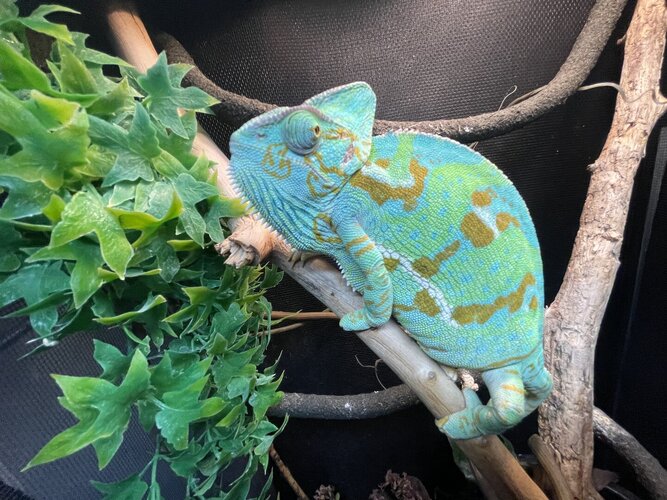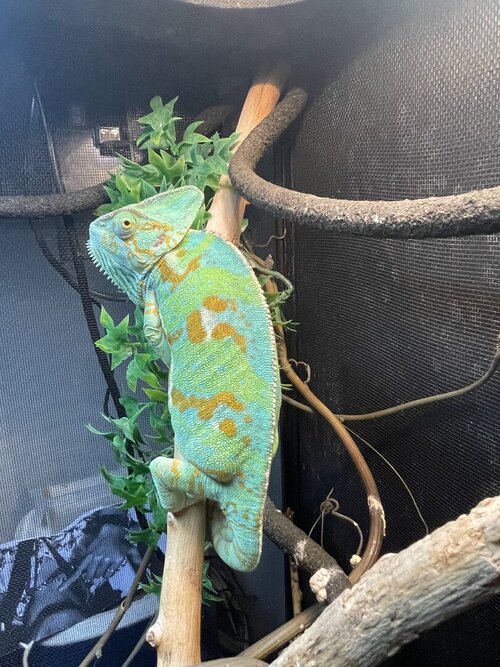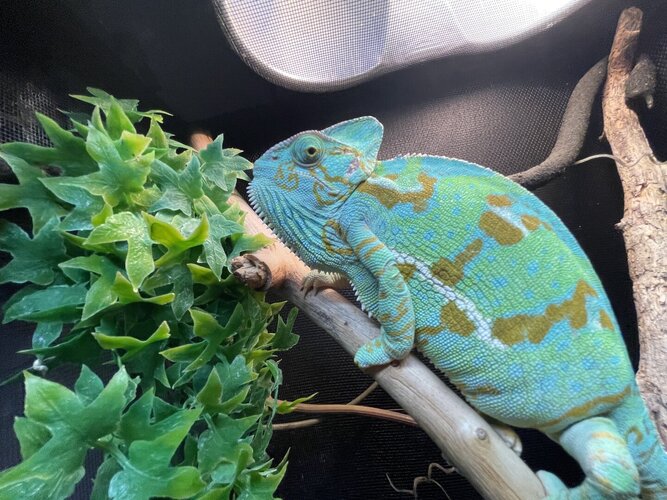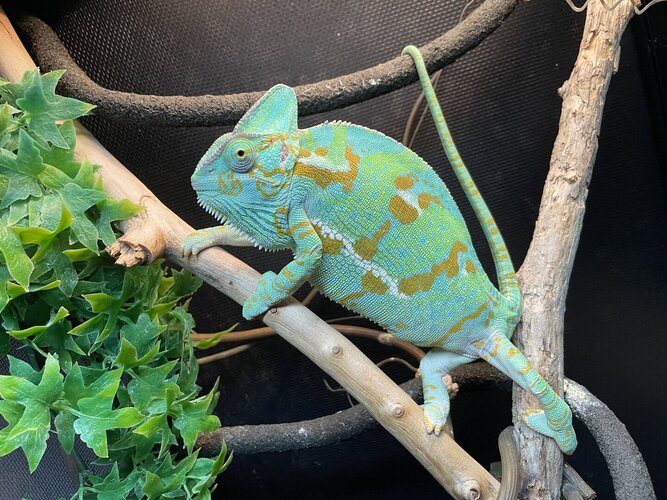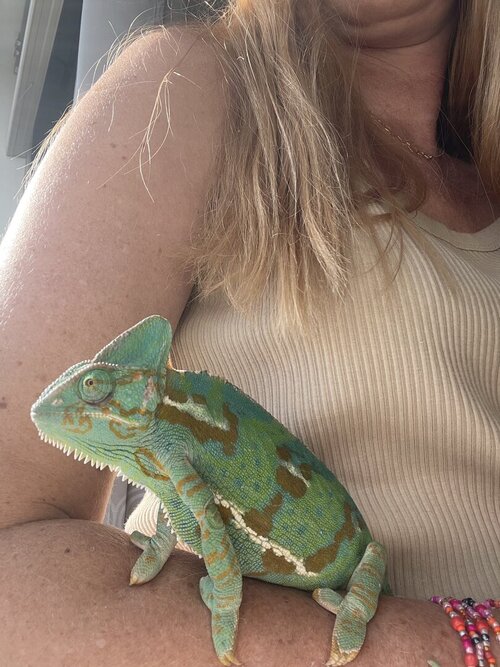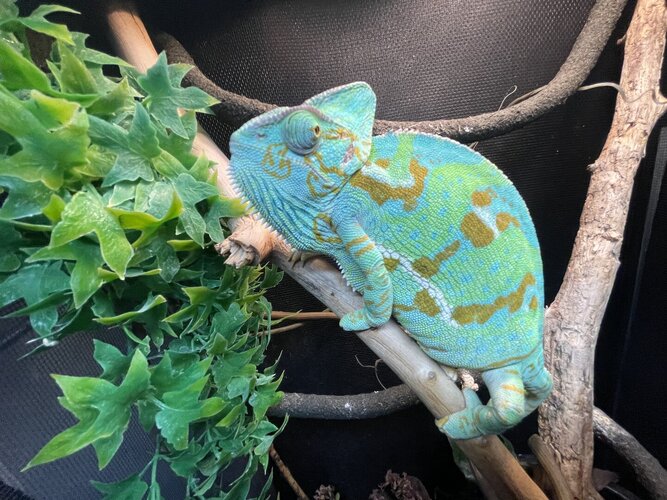Navigation
Install the app
How to install the app on iOS
Follow along with the video below to see how to install our site as a web app on your home screen.
Note: This feature may not be available in some browsers.
More options
You are using an out of date browser. It may not display this or other websites correctly.
You should upgrade or use an alternative browser.
You should upgrade or use an alternative browser.
Is she pregnant or just fat? Or anything else?
- Thread starter ronnietherockstar
- Start date
lurker9090
Established Member
How long have you had her?
ronnietherockstar
New Member
About 2 years maybe a little lessHow long have you had her?
MissSkittles
Chameleon Enthusiast
Hi and welcome.  Has your beautiful girl laid eggs before? As you can see, we are a helpful bunch so just let us know if you need any help, advice or guidance.
Has your beautiful girl laid eggs before? As you can see, we are a helpful bunch so just let us know if you need any help, advice or guidance.
ronnietherockstar
New Member
No she hasntHi and welcome.Has your beautiful girl laid eggs before? As you can see, we are a helpful bunch so just let us know if you need any help, advice or guidance.
ronnietherockstar
New Member
Me and my dad do have a lay bin for her, It’s a mix of sand and dirt and is not to dry but not to wet so she can tunnel.Welcome to the forum. You want to add a lay bin. She is quite big and close to laying eggs. Hopefully the clutch will not be too large.
Do you know how to set up a lay bin and the proper media for it?
ronnietherockstar
New Member
My dad does the feeding due to my busy schedule, so I’ll get back to about that but yes we have a lay binhello and welcome! She is beautiful! It looks like she has her receptive colors going meaning she is looking for a boyfriend or was looking for one. She does look quite big. How much do you feed her? Do you have a lay bin for your girl?
Which UVB lighting are yall using? Do you have the long T5HO bar or are you using a chameleon kit with the double dome lighting? If double dome UVB then she would be high risk for developing metabolic bone disease. Which is more dangerous for females due to egg laying.
ronnietherockstar
New Member
Attachments
-
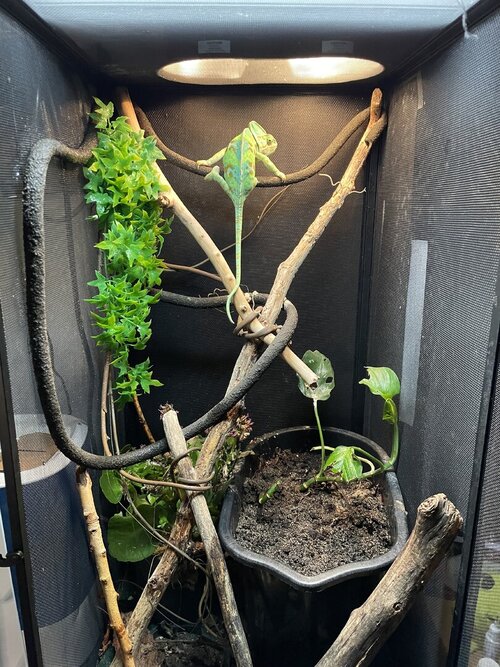 IMG_1148.jpeg288.8 KB · Views: 82
IMG_1148.jpeg288.8 KB · Views: 82 -
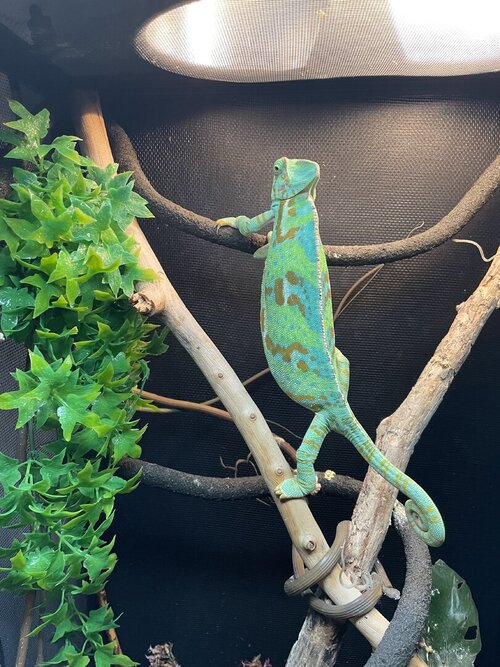 IMG_1146.jpeg251.6 KB · Views: 78
IMG_1146.jpeg251.6 KB · Views: 78 -
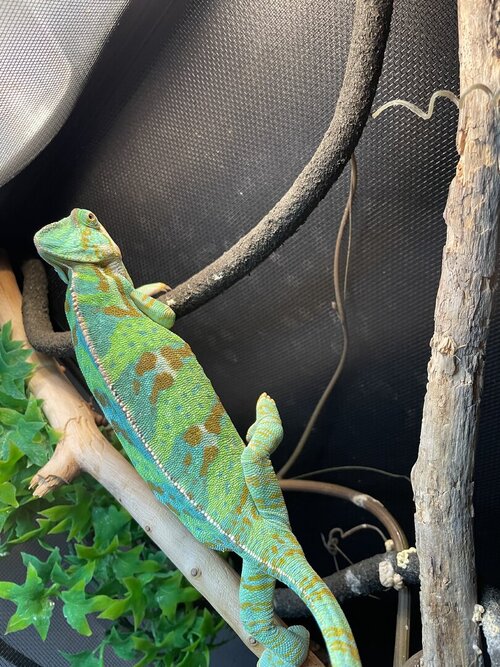 IMG_1145.jpeg270.3 KB · Views: 87
IMG_1145.jpeg270.3 KB · Views: 87 -
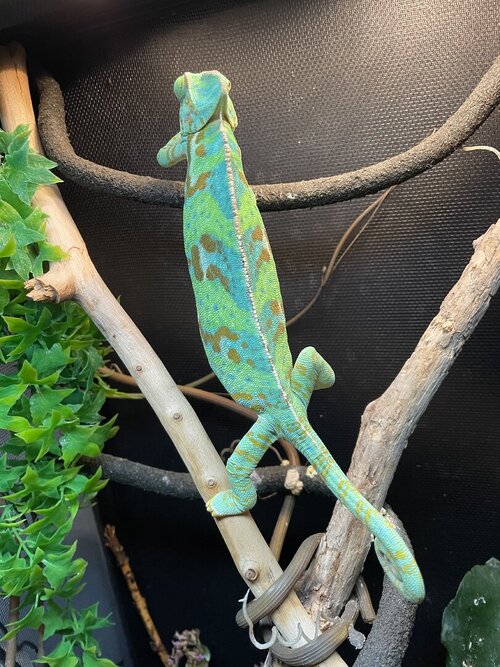 IMG_1144.jpeg255.5 KB · Views: 80
IMG_1144.jpeg255.5 KB · Views: 80 -
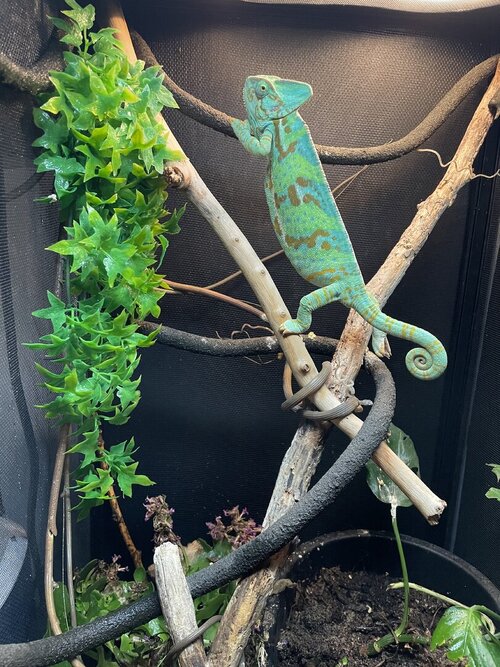 IMG_1143.jpeg284.5 KB · Views: 81
IMG_1143.jpeg284.5 KB · Views: 81 -
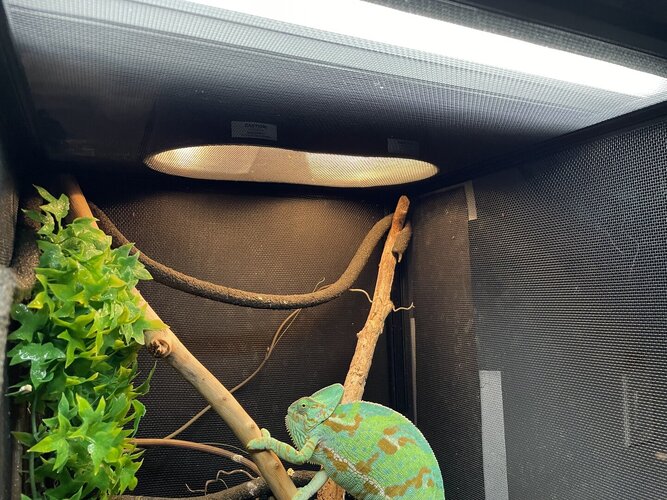 IMG_1142.jpeg496 KB · Views: 82
IMG_1142.jpeg496 KB · Views: 82 -
 IMG_1135.jpeg156.5 KB · Views: 79
IMG_1135.jpeg156.5 KB · Views: 79 -
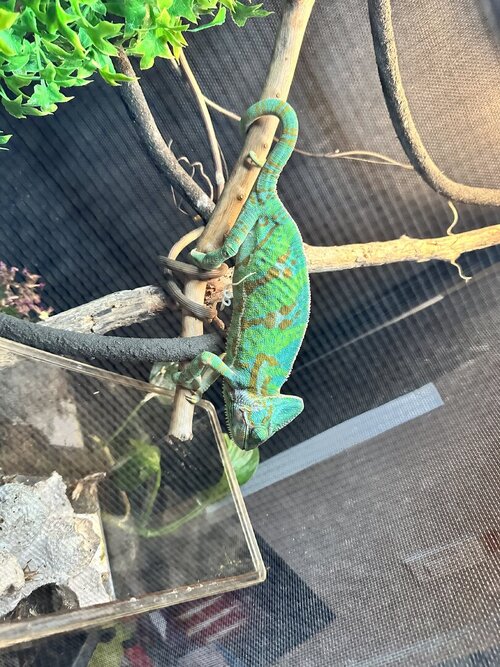 IMG_1066.jpeg276.6 KB · Views: 90
IMG_1066.jpeg276.6 KB · Views: 90 -
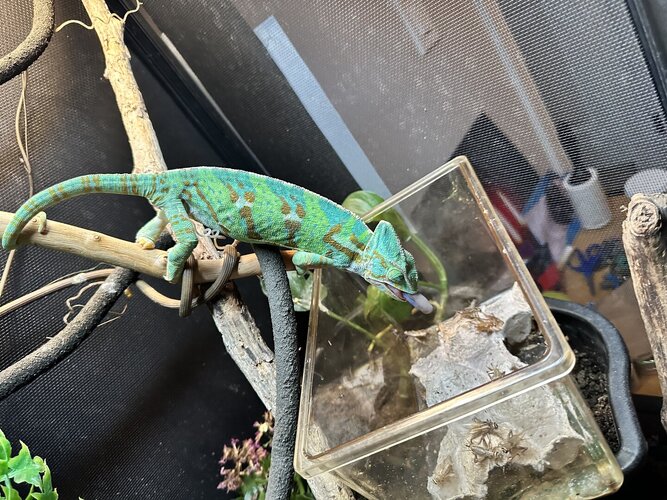 IMG_1068.jpeg449.4 KB · Views: 90
IMG_1068.jpeg449.4 KB · Views: 90
MissSkittles
Chameleon Enthusiast
Is she eating and if so, is the same amount that she has been? How much and how often have you been feeding her? What supplements do you use and what is the schedule for them? These things are really important to know to determine if everything will be uneventful or require careful monitoring.
She does look very big and lumpy, which indicates eggs. Has she been restless lately - wandering all around her enclosure and paying special attention the the bottom? I’m not sure about your lay bin - it looks small. However, (and please don’t take this as me being mean), your entire enclosure looks a bit too small. I’d like to offer my help in getting everything as perfect as possible for your pretty little (infertile) momma. Much depends on how close she is to laying her eggs though. If she’s just days away, I don’t want to tell you to be making any changes that will stress her.
The standard minimum size enclosure for her is a 2x2x4’. Then you need to fill it up with lots of plants, branches and vines to create a forest edge type of space. Providing a pic below to give you and idea of what I mean. Veileds and especially the girls nibble their plants, so it’s essential to have only safe live plants. Pothos is awesome. My girls always preferred a lay bin that was at least 12” long, wide and deep. I only fill it to about 5-6” with washed play sand that is kept moist enough to hold a tunnel without collapse. You can do a 50/50 mix of sand and organic soil if you like. Also, you’ll want some small drainage holes in the bottom so it won’t become a muddy mess after misting.
More to come….
This is for a panther so I’m able to use plants that aren’t necessarily ‘veiled safe’ Although I have used all with a veiled before with no problem.

She does look very big and lumpy, which indicates eggs. Has she been restless lately - wandering all around her enclosure and paying special attention the the bottom? I’m not sure about your lay bin - it looks small. However, (and please don’t take this as me being mean), your entire enclosure looks a bit too small. I’d like to offer my help in getting everything as perfect as possible for your pretty little (infertile) momma. Much depends on how close she is to laying her eggs though. If she’s just days away, I don’t want to tell you to be making any changes that will stress her.
The standard minimum size enclosure for her is a 2x2x4’. Then you need to fill it up with lots of plants, branches and vines to create a forest edge type of space. Providing a pic below to give you and idea of what I mean. Veileds and especially the girls nibble their plants, so it’s essential to have only safe live plants. Pothos is awesome. My girls always preferred a lay bin that was at least 12” long, wide and deep. I only fill it to about 5-6” with washed play sand that is kept moist enough to hold a tunnel without collapse. You can do a 50/50 mix of sand and organic soil if you like. Also, you’ll want some small drainage holes in the bottom so it won’t become a muddy mess after misting.
More to come….
This is for a panther so I’m able to use plants that aren’t necessarily ‘veiled safe’ Although I have used all with a veiled before with no problem.
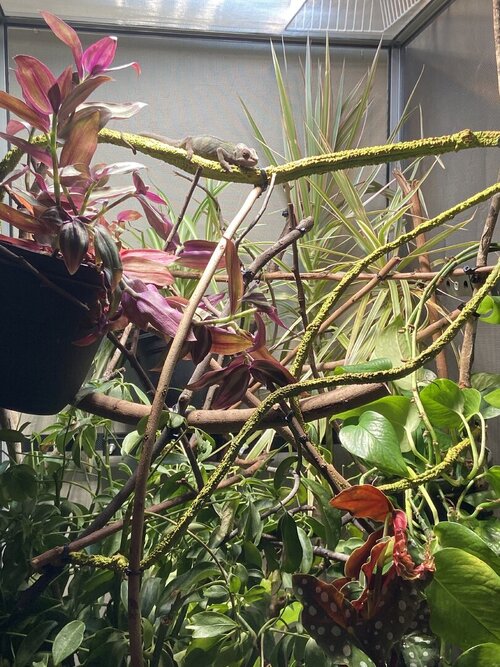
MissSkittles
Chameleon Enthusiast
Since your girl hasn’t laid eggs before, I just want to give you some advice and info on how it goes and what to do.
One morning you’ll find your girl has started digging. It is absolutely essential that she is not disturbed for anything less than the house being on fire - seriously! I would suggest getting things ready by covering up at least the lower 1/2 or 1/3 of your enclosure with a light cotton cover. Do make sure to leave most or all of the bottom service door uncovered for proper air flow. This will provide her the sense of security that she needs to be able to feel comfortable enough to lay her precious eggs. She doesn’t know nor care that they’re infertile. Anyhow, once she starts digging if she sees anyone or is made to feel unsafe, she will stop digging and risk becoming eggbound. I cut peek holes in my cover sheet so I can monitor without being seen. Once she’s digging, no need to worry about feeding her. You can set up a dripper if you don’t have an automatic mister, but make sure it isn’t going into the bin. She may dig a few test holes until she likes one. Then she’ll dig all the way down and usually against the side, turn around and lay her eggs. This takes time and she may sleep in her tunnel. When she’s laid all her eggs, she’ll carefully cover all holes and once there’s no sign of anything, she’ll return to her basking branch. The entire process can take a couple of days. When she’s done, feed and hydrate her very well for a couple of days. Then you want to start her diet of 3-4 feeders, 3 days a week and keep her basking temp no higher than 80F. This will help reduce her egg production and laying, which will help prolong her life.
Signs that there is a problem - she starts and stops digging in various places and over several days with no real progress. She starts dropping eggs here and there. She stops eating, drinking and is lethargic, sitting on the bottom of the enclosure. She has her eyes closed during the day. Looking like she is straining. Passing blood. If you notice any of these, she will need to be taken to a good vet without delay. The longer you wait, the weaker she will become. Make sure to know what vet in your area sees chameleons, has experience with them (especially egg bound ones) and you know what their hours are.
I know I’ve thrown a lot of info at you right now, so do ask any questions you may have.
One morning you’ll find your girl has started digging. It is absolutely essential that she is not disturbed for anything less than the house being on fire - seriously! I would suggest getting things ready by covering up at least the lower 1/2 or 1/3 of your enclosure with a light cotton cover. Do make sure to leave most or all of the bottom service door uncovered for proper air flow. This will provide her the sense of security that she needs to be able to feel comfortable enough to lay her precious eggs. She doesn’t know nor care that they’re infertile. Anyhow, once she starts digging if she sees anyone or is made to feel unsafe, she will stop digging and risk becoming eggbound. I cut peek holes in my cover sheet so I can monitor without being seen. Once she’s digging, no need to worry about feeding her. You can set up a dripper if you don’t have an automatic mister, but make sure it isn’t going into the bin. She may dig a few test holes until she likes one. Then she’ll dig all the way down and usually against the side, turn around and lay her eggs. This takes time and she may sleep in her tunnel. When she’s laid all her eggs, she’ll carefully cover all holes and once there’s no sign of anything, she’ll return to her basking branch. The entire process can take a couple of days. When she’s done, feed and hydrate her very well for a couple of days. Then you want to start her diet of 3-4 feeders, 3 days a week and keep her basking temp no higher than 80F. This will help reduce her egg production and laying, which will help prolong her life.
Signs that there is a problem - she starts and stops digging in various places and over several days with no real progress. She starts dropping eggs here and there. She stops eating, drinking and is lethargic, sitting on the bottom of the enclosure. She has her eyes closed during the day. Looking like she is straining. Passing blood. If you notice any of these, she will need to be taken to a good vet without delay. The longer you wait, the weaker she will become. Make sure to know what vet in your area sees chameleons, has experience with them (especially egg bound ones) and you know what their hours are.
I know I’ve thrown a lot of info at you right now, so do ask any questions you may have.

